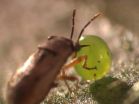(Press-News.org) This press release is available in German.
To solve the acute, global problem of securing food resources for a continuously growing population, we must work constantly to increase the sustainability and effectiveness of modern agricultural techniques. These efforts depend on new insights from plant ecology, particularly from work on native plants that grow in the primordial agricultural niche. Based on field studies on wild tobacco plants in the Great Basin Desert, Utah, USA, researchers of the Max Planck Institute for Chemical Ecology in Jena, Germany, demonstrated that the release of volatiles which attract enemies of herbivores not only controls insect pests, but also increases the reproduction of infested plants. Transferred to the goals of integrated pest management, this means that these natural plant defenses can be utilized to improve and increase agricultural yields in an environmentally friendly manner. These results were published on October 15, 2012, as part of the launch of the new open-access journal eLife.
Defense against herbivores is not automatically linked to yield increases
For three decades, ecologists have observed that plants emit specific volatiles after herbivory, causing a striking effect: they can reduce the number of insect attackers on a plant by up to 90 percent, because herbivores' enemies can recognize such volatiles as a "call to dinner". Typical examples are the attraction of parasitic wasps or predatory bugs after leaves have been attacked by moth larvae, or the underground "cry for help" emitted by maize roots to attract nematodes feeding on corn rootworm larvae. However, until now, one important question for farmers remained unanswered: Does the so-called indirect defense reaction of a plant positively influence the plant's fitness, its vegetative and especially reproductive growth, the generation of flowers and seeds: its ability to produce grandchildren? For this cannot be taken for granted. Defense reactions, such as the emission of odor molecules or the synthesis of digestive inhibitory substances, are costly and may attract foes as well as friends, or squander resources needed for seed maturation. After defending itself, a plant may survive, but at what cost? Is it really better off than if it had simply tolerated the herbivorous foe? Natural defenses, or in other words biological control, are only useful for agriculture if they secure or, better, increase expected yield.
With only very few exceptions, plants emit green leaf volatiles (GLVs) when damaged. The GLVs released by damaged wild tobacco attract Geocoris bugs which attack herbivores, most importantly young herbivorous Manduca larvae: each Manduca larva, if allowed to grow to full size, can consume multiple full-grown wild tobacco plants! The emission of specific GLVs, including (E)-2-hexenal and related compounds, increases as soon as freshly hatched Manduca larvae start feeding on leaves – and so Geocoris can tell whether the GLVs come from Manduca feeding as opposed to any other damage. In contrast, proteinase inhibitors (PIs) are synthesized in the leaves to interfere with the digestion of leaf proteins and thus render the plant less nutritious to herbivores; hence, they can weaken feeding caterpillars. Both GLVs and PIs have been shown to reduce the number of particular herbivores, or the amount of damage they cause, for plants growing in nature over the course of short field trials. This time, researchers asked the question: do these compounds increase yield, i.e. reproduction, over the full growing season of a plant? In other words, are plants which produce these compounds really fitter than those that don't?
In the summers of 2010 and 2011, Meredith Schuman, Kathleen Barthel and Ian Baldwin performed field experiments with transgenic GLV-deficient and PI-deficient wild tobacco plants in the plants' native habitat, Utah, USA. They were able to demonstrate that GLV emission not only reduced the number of Manduca caterpillars and eggs on plants, but also increased flower and bud production of plants attacked by Manduca. On the other hand, no significant correlation between the formation of PIs and an increase in the number of buds or flowers was found. However, the scientists hypothesized that PIs might still weaken the caterpillars; as a consequence, the malnourished larvae might be less able to fight back against predators. This in turn could have an indirect, positive effect on flower production. To test this assumption, the researchers conducted an interesting experiment: They put Manduca larvae on either wild-type or PI-deficient plants, let them feed for two days, and subsequently imitated the attack of predatory bugs using pins and forceps. Caterpillars that had been feeding on wild-type leaves and ingesting PIs only sluggishly responded to the attack, whereas larvae that had been feeding on PI-free leaves vigorously defended themselves against the "human" assault. (Please watch the corresponding short movies at http://www.ice.mpg.de/ext/735.html)
Reduction of pesticide use
Bio-organic farming is an agricultural approach which uses biological pest control as an alternative to toxic synthetic insecticides, for example employing parasitic wasps against the dangerous larvae of the European corn borer. The results described here show that GLVs might be used to increase the effectiveness of such biological control. Like farmers using parasitic wasps, wild tobacco plants "use" Geocoris predators, attracting them with GLVs to predate Manduca herbivores. GLVs have been shown to attract other predators and parasitoids, and are emitted by all crop plants studied. "Such 'indirect' pest control may also help to avoid the common problem of pests developing resistance to toxic pesticides", says Ian Baldwin from the Max Planck Institute for Chemical Ecology.
The research results presented here were published in the international journal eLife, which is being launched with support from the Howard Hughes Medical Institute, the Wellcome Trust, and the Max Planck Society. eLife represents a new model of scientific publishing, designed to meet the needs of scientists in life sciences and biomedicine in a better way. This includes free, immediate, online access to scientific articles, as well as rapid, fair, and constructive review – in short, a journal for scientists, run by scientists. Initial decisions are made by eLife's senior editors, and, if a submission is selected for further assessment, full peer review is overseen by eLife's 175-member board of reviewing editors. The reviewing editor and reviewers consult once peer review comments are submitted, and provide a consolidated list of instructions to authors – eliminating unnecessary and time-consuming rounds of revision. For an initial period, there will be no charge to publish in eLife. [JWK/AO]
INFORMATION:
Original Publication:
Meredith C. Schuman, Kathleen Barthel, Ian T. Baldwin (2012). Herbivory-induced volatiles function as defenses increasing fitness of the native plant Nicotiana attenuata in nature. eLife, doi: 10.7554/elife.00007
dx.doi.org/10.7554/elife.00007
Further Information:
Prof. Dr. Ian T. Baldwin, baldwin@ice.mpg.de, +49 (0)3641-57 1100
http://www.elifesciences.org/
Picture Requests:
Angela Overmeyer M.A., +49 3641 57-2110, overmeyer@ice.mpg.de
or download from http://www.ice.mpg.de/ext/735.html
Green leaf volatiles increase plant fitness via biocontrol
Field study published in the new scientific journal eLife reveals that biological pest control using predators of insect eggs and larvae increases plant fitness
2012-10-16
ELSE PRESS RELEASES FROM THIS DATE:
An extremely brief reversal of the geomagnetic field, climate variability and a super volcano
2012-10-16
An extremely brief reversal of the geomagnetic field, climate variability and a super volcano
41,000 years ago, a complete and rapid reversal of the geomagnetic field occured. Magnetic studies of the GFZ German Research Centre for Geosciences on sediment cores from the Black Sea show that during this period, during the last ice age, a compass at the Black Sea would have pointed to the south instead of north. Moreover, data obtained by the research team formed around GFZ researchers Dr. Norbert Nowaczyk and Prof. Helge Arz, together with additional data from other studies ...
Link between creativity and mental illness confirmed
2012-10-16
People in creative professions are treated more often for mental illness than the general population, there being a particularly salient connection between writing and schizophrenia. This according to researchers at Karolinska Institutet in Sweden, whose large-scale registry study is the most comprehensive ever in its field.
Last year, the team showed that artists and scientists were more common amongst families where bipolar disorder and schizophrenia is present, compared to the population at large. They subsequently expanded their study to many more psychiatric diagnoses ...
Non-coding antisense RNA can be used to stimulate protein production
2012-10-16
While studying Parkinson's disease, an international research group made a discovery which can improve industrial protein synthesis for therapeutic use. They managed to understand a novel function of non-protein coding RNA: the protein synthesis activity of coding genes can be enhanced by the activity of the non-coding one called "antisense."
To synthesize proteins, the DNA needs RNA molecules serving as short "transcriptions" of the genetic information. The set of all these RNA molecules is called "transcriptome." In the human transcriptome, along with around 25 thousand ...
Genetic protection against arsenic
2012-10-16
Evolution has not only controlled human development over millions of years, it also has an impact on modern man. This is one of the conclusions of a study of Argentinian villagers in the Andes, where the water contains high levels of arsenic. A gene variant that produces efficient and less toxic metabolism of arsenic in the body was much more common among the villagers than among other indigenous groups in South or Central America. The study was a collaborative effort by Karin Broberg from Lund University and Carina Schlebusch and Mattias Jakobsson from Uppsala University ...
Dark matter filament studied in 3-D for the first time
2012-10-16
Astronomers using the NASA/ESA Hubble Space Telescope have studied a giant filament of dark matter in 3D for the first time. Extending 60 million light-years from one of the most massive galaxy clusters known, the filament is part of the cosmic web that constitutes the large-scale structure of the Universe, and is a leftover of the very first moments after the Big Bang. If the high mass measured for the filament is representative of the rest of the Universe, then these structures may contain more than half of all the mass in the Universe.
The theory of the Big Bang predicts ...
The sound in Saturn's rings: RUB-Physicists explain nonlinear dust acoustic waves in dusty plasmas
2012-10-16
Dusty plasmas can be found in many places both in space and in the laboratory. Due to their special properties, dust acoustic waves can propagate inside these plasmas like sound waves in air, and can be studied with the naked eye or with standard video cameras. The RUB physicists Prof. Dr. Dr. h.c. Padma Kant Shukla and Dr. Bengt Eliasson from the Faculty of Physics and Astronomy have published a model with which they describe how large amplitude dust acoustic waves in dusty plasmas behave. The researchers report their new findings in the journal Physical Review E.
Different ...
Novel discovery links anti-cancer drugs to muscle repair
2012-10-16
OTTAWA, October 16, 2012 – Few drugs are available to treat muscle injury, muscle wasting and genetic disorders causing muscle degeneration, such as Duchenne muscular dystrophy. A compelling discovery that may change this was made recently by a research group led by Dr. Robert Korneluk, distinguished professor at University of Ottawa's Faculty of Medicine and founder of the CHEO Research Institute's Apoptosis Research Centre, was reported today in Science Signaling.
"We know of five pharmaceutical companies pursuing phase one clinical trials with specific drugs to treat ...
Pollenizer research should help seedless watermelon farmers
2012-10-16
Research from North Carolina State University on flower production and disease resistance in watermelon varieties should help bolster seedless watermelon harvests for farmers.
Seedless watermelons are more popular than seeded watermelons, making them a more profitable crop for farmers. But the flowers of seedless watermelon plants must be fertilized with pollen from the male flowers of seeded watermelon plants, because seedless plants do not produce genetically viable pollen.
This is a problem, because seeded watermelon plants take up space, nutrients and water that ...
A change of strategy is needed to save the Sumatran orangutans
2012-10-16
This press release is available in German.
Orangutans are the only large apes in Asia and mainly live in trees. Today, the population only includes two species: While the Borneo orangutan populates large sections of the Southeast Asian island of Borneo, nowadays the Sumatran orangutan is only found at the northern tip of the island of Sumatra. With a current population of only around 6,600 Sumatra orangutans, a figure which is dropping rapidly and constantly, this species is on the Red List of Threatened Species.
When large areas of rainforest were cleared in Sumatra ...
Less-invasive method of brain stimulation helps patients with Parkinson's disease
2012-10-16
Philadelphia, Pa. (October 16, 2012) – Electrical stimulation using extradural electrodes—placed underneath the skull but not implanted in the brain—is a safe approach with meaningful benefits for patients with Parkinson's disease, reports the October issue of Neurosurgery, official journal of the Congress of Neurological Surgeons. The journal is published by Lippincott Williams & Wilkins, a part ofWolters Kluwer Health.
The technique, called extradural motor cortex stimulation (EMCS), may provide a less-invasive alternative to electrical deep brain stimulation (DBS) ...
LAST 30 PRESS RELEASES:
Tracing the quick synthesis of an industrially important catalyst
New software sheds light on cancer’s hidden genetic networks
UT Health San Antonio awarded $3 million in CPRIT grants to bolster cancer research and prevention efforts in South Texas
Third symposium spotlights global challenge of new contaminants in China’s fight against pollution
From straw to soil harmony: International team reveals how biochar supercharges carbon-smart farming
Myeloma: How AI is redrawing the map of cancer care
Manhattan E. Charurat, Ph.D., MHS invested as the Homer and Martha Gudelsky Distinguished Professor in Medicine at the University of Maryland School of Medicine
Insilico Medicine’s Pharma.AI Q4 Winter Launch Recap: Revolutionizing drug discovery with cutting-edge AI innovations, accelerating the path to pharmaceutical superintelligence
Nanoplastics have diet-dependent impacts on digestive system health
Brain neuron death occurs throughout life and increases with age, a natural human protein drug may halt neuron death in Alzheimer’s disease
SPIE and CLP announce the recipients of the 2025 Advanced Photonics Young Innovator Award
Lessons from the Caldor Fire’s Christmas Valley ‘Miracle’
Ant societies rose by trading individual protection for collective power
Research reveals how ancient viral DNA shapes early embryonic development
A molecular gatekeeper that controls protein synthesis
New ‘cloaking device’ concept to shield sensitive tech from magnetic fields
Researchers show impact of mountain building and climate change on alpine biodiversity
Study models the transition from Neanderthals to modern humans in Europe
University of Phoenix College of Doctoral Studies releases white paper on AI-driven skilling to reduce burnout and restore worker autonomy
AIs fail at the game of visual “telephone”
The levers for a sustainable food system
Potential changes in US homelessness by ending federal support for housing first programs
Vulnerability of large language models to prompt injection when providing medical advice
Researchers develop new system for high-energy-density, long-life, multi-electron transfer bromine-based flow batteries
Ending federal support for housing first programs could increase U.S. homelessness by 5% in one year, new JAMA study finds
New research uncovers molecular ‘safety switch’ shielding cancers from immune attack
Bacteria resisting viral infection can still sink carbon to ocean floor
Younger biological age may increase depression risk in older women during COVID-19
Bharat Innovates 2026 National Basecamp Showcases India’s Most Promising Deep-Tech Ventures
Here’s what determines whether your income level rises or falls
[Press-News.org] Green leaf volatiles increase plant fitness via biocontrolField study published in the new scientific journal eLife reveals that biological pest control using predators of insect eggs and larvae increases plant fitness



